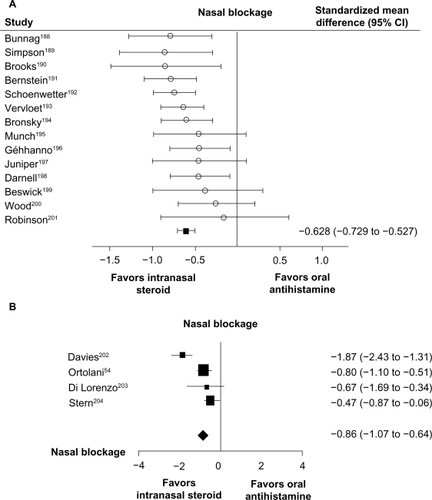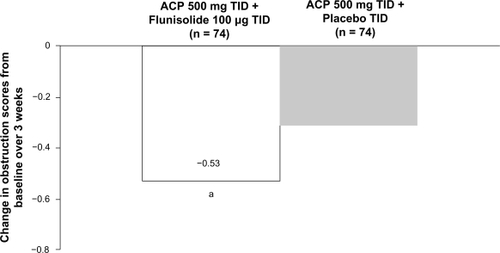Figures & data
Figure 1 Least squares mean change in the composite daytime nasal symptoms score and its components during a 6-week trial of montelukast versus placebo in patients with perennial allergic rhinitis. Baseline scores are shown above the bars. aP < 0.001; bP < 0.05. Error bars represent SE. Reproduced with permission from Patel P, Philip G, Yang W, et al Randomized, double-blind, placebo-controlled study of montelukast for treating perennial allergic rhinitis. Ann Allergy Asthma Immunol. 2005; 95(6):551–557.Citation72 Copyright © 2005 American College of Allergy, Asthma and Immunology.

Figure 2 Nasal obstruction mean score versus treatment days. P < 0.001 for COM vs CTZ; P = 0.004 for COM vs PER; P = 0.128 for CTZ vs PER. Reproduced with permission from Bertrand B, Jamart J, Marchal JL, Arendt C. Cetirizine and pseudoephedrine retard alone and in combination in the treatment of perennial allergic rhinitis: a double-blind multicentre study. Rhinology. 1996;34(2):91–96.Citation23 Copyright © 1996 International Rhinologic Society.

Figure 3 A) Meta-analysis of intranasal corticosteroids versus oral H1-receptor antagonists for the treatment of nasal blockage in allergic rhinitis. Intranasal steroids included beclomethasone dipropionate, fluticasone propionate, triamcinolone acetonide, and budesonide. Oral antihistamines included dexchlorpheniramine, terfenadine, astemizole, loratadine, and cetirizine. Adapted with permission from British Medical Journal, Weiner JM, Abramson MJ, Puy RM, volume 317, 1624–1629, Copyright © 1998 with permission from BMJ Publishing Group Ltd.Citation27 B) Meta-analysis of intranasal corticosteroids versus topical H1-receptor antagonists for the treatment of nasal blockage in allergic rhinitis. Intranasal steroids included beclomethasone dipropionate, fluticasone propionate, and budesonide. Topical antihistamines included azelastine and levocabastine. Adapted with permission from Yáñez A, Rodrigo GJ. Intranasal corticosteroids versus topical H1 receptor antagonists for the treatment of allergic rhinitis: a systematic review with metaanalysis. Ann Allergy Asthma Immunol. 2002;89(5):479–484.Citation28 Copyright © 2002 American College of Allergy, Asthma and Immunology.

Figure 4 Percent change in congestion symptom score in a pooled analysis of 4 studies with mometasone furoate in seasonal allergic rhinitis. The magnitude of change was greatest in patients with the highest baseline congestion scores. Mean baseline congestion scores in the overall population were 2.24 in the mometasone furoate group and 2.25 in the placebo group. In the >2.5 baseline congestion score group, the baseline scores were 2.83 (mometasone furoate) and 2.84 (placebo). In the >2.75 group, the baseline scores were 2.94 in both the mometasone furoate and placebo groups. aP < 0.001 vs placebo. Adapted with permission from Berger WE, Nayak AS, Staudinger HW. Mometasone furoate improves congestion in patients with moderate-to-severe seasonal allergic rhinitis. Ann Pharmacother. 2005;39(12):1984–1989.Citation100 Copyright © 2005 Harvey Whitney Books Co.

Figure 5 Mean change in turbinate swelling/obstruction score over 3 weeks in patients with acute rhinosinusitis treated with amoxicillin clavulanate potassium (ACP) 500 mg 3 times daily (TID) and either flunisolide 100 μg 3 times daily or placebo 3 times daily. aP = 0.041 versus ACP 500 mg 3 times daily + placebo TID. Reprinted from J Allergy Clin Immunol, Vol 92, Meltzer EO, Orgel HA, Backhaus JW, et al. Intranasal flunisolide spray as an adjunct to oral antibiotic therapy for sinusitis. Pages 812–823, Copyright © 1993, with permission from Mosby-Year Book, Inc.Citation115

Table 1 Treatment of some less common rhinopathies